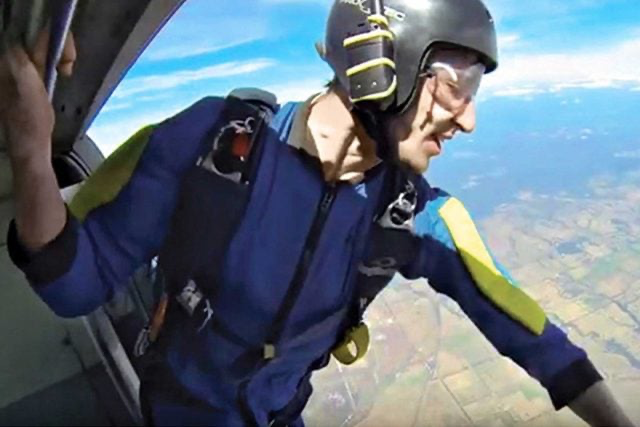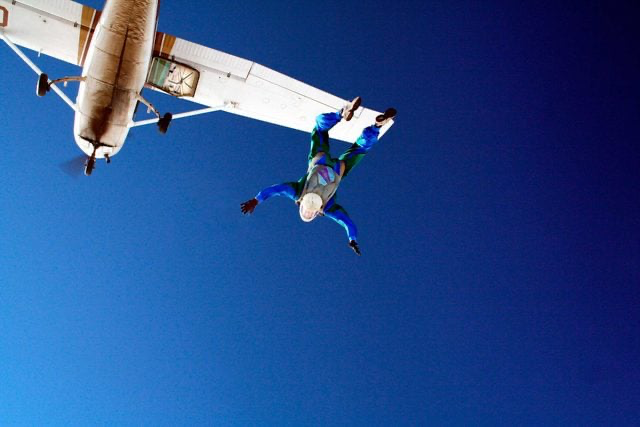Christopher Jones, a trainee skydiver, is tightly packed into a Cessna 182 with fellow skydivers over the Australian countryside near Perth. It’s just after 4 p.m., and this will be Jones’s fifth jump in his accelerated freefall training program. Unlike his previous jumps, he’ll be going solo this time, without an instructor tethered to him.
As the plane climbs through the clear, crisp November sky, Jones mentally reviews the day’s procedures. His heart races, but he feels confident about his first solo jump. Sitting in the back of the plane, he mentally checks off the maneuvers he needs to execute.
At 12,000 feet, a green light flashes on the wall, signaling from the pilot that it’s time to jump. Though Jones will manage his parachute independently, he won’t be entirely alone. Veteran parachutist Sheldon McFarlane, with 25 years of experience and over 10,000 jumps, will be right behind him. McFarlane opens the plane’s side door and motions for Jones to assume the ready position near the exit.
Despite wearing a helmet, goggles, jumpsuit, and two parachutes (main and reserve), Jones winces as the cold air rushes into the plane. The rushing wind drowns out all sound except for his own heartbeat. Nervous but focused, Jones relies on McFarlane’s guidance. Through hand signals and radio commands via their headsets, McFarlane will lead Jones through a set of prescribed maneuvers and plans to film the jump for Jones to review later.
Jones clings to a rail above the open door, bracing himself. He initiates the pre-jump cadence he’s learned: “Check in,” he signals with a thumbs-up to McFarlane, indicating his readiness to jump.
McFarlane responds with a return thumbs-up: “OK.”
As the strong winds buffet him, Jones gazes down at the green-and-brown checkerboard landscape below. In the distance, the bright blue expanse of the Indian Ocean comes into view.
“Sky!” Jones shouts, indicating he’s ready and has found his balance. McFarlane gives another thumbs-up in response.
Today’s solo skydive marks the fulfillment of Jones’s lifelong dream. His passion for aviation began after flying in his uncle’s small aircraft, an experience he cherished so much that he aspired to become a pilot. However, his dreams were shattered at age 12 when he was diagnosed with epilepsy, and doctors informed him that he would be unable to obtain a pilot’s license.
Despite this setback, Jones rediscovered his love for the skies through tandem skydiving in Europe. The thrill of free-falling felt like flying, captivating him. He resolved that if he couldn’t pilot a plane, he would embrace skydiving instead.
Normally, individuals with epilepsy are discouraged from solo skydiving. However, Jones had been seizure-free for over six years and received medical clearance to pursue skydiving lessons. He excelled at the WA Skydiving Academy in Jandakot, near Perth, impressing his instructors and completing his tandem jumps smoothly. Now, he stands ready for his first solo leap.
Today, Jones is ready to make a significant leap from an airplane, solo for the first time. The entire descent is expected to take about two minutes, covering the distance from the plane at 12,000 feet, or roughly two miles, to the ground. Here’s how the experience unfolds:
12,000 Feet

As Jones prepares for the jump, he stumbles and almost falls out of the Cessna. McFarlane observes the mishap, recognizing it as common for novices. Regaining his composure, Jones positions himself with his back to the sky, grips the bars flanking the door, and arches into the jump stance. He calls out to McFarlane, “Up! Down! Hard arch!”—the skydiving command for “Ready, set, go!”—and leaps from the aircraft.
McFarlane, following closely, catches up to Jones and is reassured to see him recovered from the initial stumble, now in the ideal “box man” formation: stomach facing the earth, body arched, limbs extended for stability and maneuverability. They continue their free-fall, planning to deploy their parachutes at 5,000 feet. The descent typically takes 10 seconds for the initial 1,000 feet, then 5.5 seconds for each subsequent 1,000 feet, reaching speeds of around 120 miles per hour.
McFarlane checks his altimeter and signals Jones to do the same. Everything is going well, he thinks, giving a thumbs-up.
9,000 Feet
During the free-fall, McFarlane cues Jones to initiate a left-hand turn. Jones starts the maneuver but abruptly stops and gets swept to the right. McFarlane is concerned. Jones keeps drifting rightward, prompting McFarlane to wonder about his next move.
8,000 Feet
Jones is unable to correct his failed left turn and doesn’t respond to McFarlane’s subsequent signals. It becomes clear to the experienced instructor that something is wrong.
Suddenly, Jones tucks his knees to his chest and rolls onto his back in mid-air. His arms flail wildly as he plummets. McFarlane watches with concern, realizing that Jones is struggling to maintain control.
At 7,000 feet, Jones is caught in a helpless spin on his back. McFarlane has seen novices overwhelmed by sensory overload before, but this seems different. Jones had excelled in his tandem jumps, yet now, during his solo dive, the risk is much greater—it’s a matter of life and death.
McFarlane yells, “Come on, Christopher!” not realizing that Jones, who has epilepsy, is having a seizure and has lost consciousness. He’s unable to deploy his parachute and is plummeting to the earth at an alarming speed.
At 6,000 feet, Jones is still spiraling downward, headfirst. McFarlane knows immediate action is necessary. Although Jones’s AAD should deploy his parachute at 2,000 feet, McFarlane understands the dangers of relying solely on it, especially for a novice.
At 5,000 feet, McFarlane’s altimeter beeps urgently, but he ignores it, choosing instead to dive towards Jones to manually deploy his parachute. It’s a perilous move—any mistake could be fatal for both. As McFarlane closes in, he realizes he’s approaching too quickly. Concerned about a collision or a tangled chute, he halts his rescue attempt. Jones remains unconscious, tumbling through the sky.
4,500 Feet
The beeping from McFarlane’s altimeter grows more insistent, signaling the urgency as he flares his chute to slow his descent momentarily. Time is critical, as deploying a parachute below 2,000 feet is highly risky, even for expert skydivers, and McFarlane is only 14 seconds away from this dangerous altitude.
Determined, he makes another dive towards Jones. This time, he maneuvers with precision, reminiscent of Superman, and manages to secure Jones’s harness. It’s crucial to position Jones correctly before deploying the parachute to avoid entanglement. With a firm grip on the harness and the chute handle, McFarlane pulls sharply. The parachute unfurls, positioning Jones upright in his harness.
McFarlane breathes a silent prayer of thanks as Jones is lifted by the inflating chute. However, Jones remains unconscious, unaware of his descent under the expansive yellow canopy. A rough landing could still be fatal.
At 4,000 feet, McFarlane deploys his own parachute and hastens his descent with controlled turns.
On the ground, the instructor overseeing the jump, Donna Cook, has been trying to communicate with Jones without success. When Jones’s parachute opens, she initially feels a surge of relief. However, her relief turns to worry as Jones fails to respond and veers off course. She radios instructions to correct his path, but the lack of response indicates that something is seriously wrong.
At 3,500 feet, Cook observes Jones drifting farther off course. Unsure whether he’s blacked out or incoherent, she continues to guide him via radio, hoping he can hear her: “Turn right, Chris! Turn right!”
3,000 Feet
Jones, slumped in his parachute, regains consciousness. It feels like waking from a deep sleep, but he notices the ground rapidly approaching. Lifting his head, he’s astonished to find himself descending under an open parachute canopy.
“How the…?” he wonders. Realizing he blacked out, his skydiving training kicks in. He checks his altimeter, which reads 3,000 feet—the last time he recalls checking it was at 9,000 feet, following McFarlane’s instructions. Unsure of how long he was unconscious, he knows he must act quickly.
“Check the canopy,” he instructs himself. Looking up, he confirms it’s open and untangled.
Next, he orients himself, spotting the drop zone—a distant white fabric arrow to the west. Before he can review other landing procedures, the one-way radio in his helmet crackles.
“Chris! Chris!” Cook’s voice crackles through Jones’s helmet radio. “Fly toward the ocean. To your right!” Realizing he’s significantly off course, Jones pulls hard on his steering handle.
2,000 Feet
Guided by the wind, Jones adjusts the parachute toggle, aiming for the drop zone now visible below. Cook is elated to see Jones finally responding: “Great!” she radios. “You’re doing great!”
“Turn your back to the ocean,” Cook instructs. Jones follows her guidance.
“That’s it! You’re doing it!” Cook encourages him, determined to maintain contact.
1,000 Feet
Meanwhile, McFarlane, already on the ground, shouts to Cook, “This was one of the worst stage-five jumps I’ve ever seen!” Unaware of Jones’s seizure, McFarlane speculates that oxygen deprivation and stress might have triggered it.
300 Feet
Jones prepares for a precise landing near the drop zone. Mentally rehearsing the safety steps, he flares his chute just moments before his feet touch down—a perfect execution, akin to that of a seasoned skydiver.
Cook’s voice crackles through the radio, filled with emotion. “You did great!” she tells Jones as he executes a flawless two-point landing and begins gathering up his parachute. Her relief and pride are palpable, and perhaps a tear or two escapes as she watches his safe descent.
After landing safely, Jones rushes to McFarlane and embraces him tightly. “Thank you so much,” he says, revealing that he had an epileptic seizure during the jump. “You just saved my life.”
In recognition of McFarlane’s swift actions and bravery, he was awarded the Gold Cross by the Royal Life Saving Society of Western Australia. Although Jones has remained seizure-free since the incident, he has chosen to retire from skydiving.
